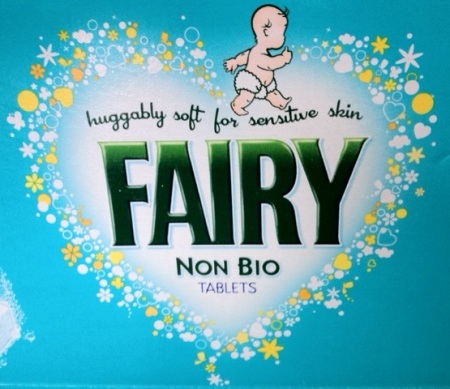You learn something new every day. The other day I reviewed John Emsley’s book on sustainable chemistry, the gist of which is that chemical engineering is woven into the fabric of our lives, literally – in terms of the clothes we wear – and metaphorically, in terms of the ubiquity of chemically-engineered materials.
I wrote that I felt insulted by his comments about non-biological washing powders. My experience was that when my son was little, wherever his skin was in contact with his washed garments – such as wrist-bands or neck-bands, he developed a rash. But after switching to non-biological washing powder, the rash disappeared. So I was pretty sure I had seen the effect of the enzymes on my son’s skin and I didn’t appreciate being told otherwise.
But nothing in life is simple. I had assumed that the difference between ‘bio’ and ‘non-bio’ powders was just in the ‘bio’-bit: the enzymes. But as it turns out, that is not the only difference.
John responded to my review and was kind enough to put me right. I will let him explain in his own words:
Fair comment, except regarding washing powders. What was causing your son’s rashes were the fragrance molecules added to the product. I used to approve adverts for TV, and part of my remit was detergents. Consequently I visited the major producers, P&G, Unilever and McBrides (who do the own label versions), and there learnt about the research that was done to uncover why the newer detergents caused skin irritations.
Eventually it was tracked down to traces of fragrance molecules that were added to these products to disguise the slightly rank odour of surfactants. As a result, they stopped using these fragrances and substituted ones that didn’t cause skin irritation. Those are the ones now used. It was never the enzymes in these products which were guilty, but those were the ingredients which were singled out as being to blame. It is only in the UK and Ireland that ‘non-bio’ washday products continue to be widely used, much to the amusement of manufacturers in the EU.
Kind regards, John.
So I will talk with my wife, and may be we will try using biological washing powder again, and see how we get on now.
Tags: Biological Washing Powder, John Emsley, Non Biological washing powder.

May 30, 2012 at 7:26 pm |
[…] for Breakfast Blog Making sense of science « 12 miles The difference between ‘Bio’ and ‘non-Bio’ […]
May 30, 2012 at 8:12 pm |
Bravo! This, as much as any of your other posts, is science in action. Not the science of ‘discoveries’ or ‘fair testing’ as taught in schools, but the simple, in-built, humble, discussion of that which is, or isn’t, true; written by a Scientist with a capital S.
You publish something. I think you’re wrong because of the evidence I observed in my household. I give you space on my blog to tell me I’m wrong. In face of new information, I accept the likelihood that I’m wrong and describe what I will do next to come to a consensus.
All this done without fuss or argument, in the spirit of finding things out. This should be taught in schools.
May 31, 2012 at 9:38 am |
And of course bio powder enables us to wash at lower temperatures thereby providing less impact on the environment.
May 31, 2012 at 9:49 am |
I’m not sure I buy this – some non-bio powders also contain fragrance molecules so surely the same irritation would also be experienced? I remember when my mother first tried biological washing powder (she hand-washed with a washboard as we didn’t have a washing machine) in the late ’60s or early ’70s the skin on her hands turned bright red and peeled off and pus oozed from the bases of her nails.
June 5, 2012 at 12:40 pm |
Please forgive the delay in replying. I am not sure what to say. John Emsley is pretty knowledgeable and I am inclined to trust him. But obviously the washing powder hurt your mum’s hands just as it hurt my son’s neck. But it could have been fragrance molecules – just different one to mask the ‘rank odour’ of the enzymes. Or it could have been enzymes….